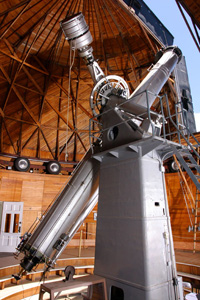
The actual location is of course ideal, Flagstaff itself is over 7000 ft above sea level, and so perched about the city on Mars hill is the Observatory. The site is a US National Historic Landmark, for this is the home of historical scientific discoveries. They have a 24-inch (0.61 m) Alvan Clark Telescope (pictured ) which is still in use today for public education. Now don’t misunderstand me, they still do real science, they currently operate four research telescopes at its Anderson Mesa dark sky site, located 20 km (12 miles) southeast of Flagstaff, including the 72-inch (1.8-meter) Perkins Telescope (in partnership with Boston University) and the 42-inch (1.1 m) John S. Hall Telescope. (But for visiting, you want the Flagstaff site).
OK, so why am I blogging about this? Bragging rights … (perhaps) … but more importantly, to highlight it and suggest that if you are ever in the area, then why not consider a visit, not just for yourself, but also for the kids. You get to look through their telescope (yes the one pictured here … no kidding). They pride themselves on reaching out to all. Its not just the big telescope, there is lots more going on as well. Once the sun sets, telescopes pop up all over with a guide at each one to explain what it is focused on. (Last night it was Saturn, the Moon and M5)
OK, so what have they actually discovered? Lots of stuff including …
- The solar system body Pluto by Clyde Tombaugh in 1930.
- Large recessional velocities of galaxies by Vesto Melvin Slipher between 1912 and 1914 (that led ultimately to the realization our universe is expanding).
- Co-discovery of the rings of Uranus in 1977.
- The periodic variation in the activity of Comet Halley during the 1985/1986 apparition.[5]
- The three largest known stars.
- The atmosphere of Pluto.
- Accurate orbits for two of Pluto’s moons: Nix and Hydra.
- Oxygen on Jupiter‘s satellite Ganymede.
- Carbon dioxide ice on three Uranian satellites.
- The first Trojan of Neptune.
- Evidence that the atmosphere of HD 209458 b contains water vapor.
To find out lots more check out the Wikipedia article on them here.
What is a visit really all about? Well, picture in your mind an 8 year old peering through the telescope and gasping when they see the actual rings of Saturn for the first time … and not just that … but also catch sight of the moons around Saturn as well. Today a visit for you is all about inspiring and motivating you and your next generation to ask questions, to reach out, and to explore.
I guess most folks come to the area to simply stick their head in holes in the ground (Grand Canyon, Meteor Crater), so why not consider one night during which you turn your face the other way and look up.